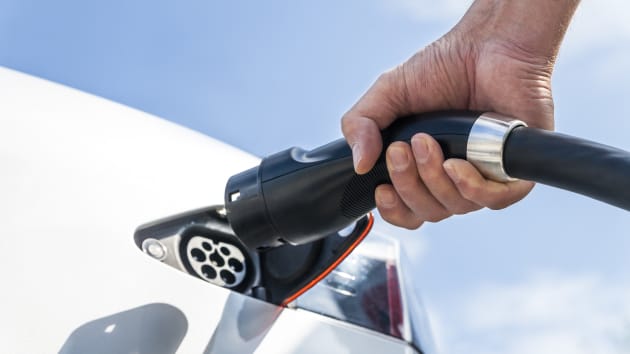Consumers may qualify for up to $10,000 — or more — in climate tax breaks and rebates in the Inflation Reduction Act - The Inflation Reduction Act includes thousands of dollars in tax credits and rebates for consumers who buy electric vehicles, install solar panels or make other energy-efficient upgrades to their homes.
- Democrats’ legislation is also expected to have indirect financial benefits for consumers, saving them an estimated $170 to $220 a year in electricity costs.
The Inflation Reduction Act, passed by House Democrats on Friday and headed to President Joe Biden’s desk for his signature, is the most ambitious climate spending package in U.S. history — and households that take steps to improve their energy efficiency stand to reap financial benefits.
The package would pump $369 billion into measures to fight climate change, boost energy security and lower electricity costs for consumers.
Largely, those investments take the form of financial incentives — such as tax breaks and rebates — for households and businesses.
For households, the incentives help make things like rooftop solar panels, electric vehicles and energy-efficient appliances more affordable, in a bid to more quickly transition the U.S. toward cleaner sources of energy. Some of the tax breaks are new, while others are enhancements or extensions of existing credits.
In all, consumers may qualify for up to $10,000 — or more — in tax breaks and rebates, depending on the scope of their purchases.
The legislation is ‘a win for consumers’Beyond those financial incentives, consumers who make efficiency-focused home upgrades would likely reap other direct benefits like lower electricity and heating bills. The legislation’s overall effect — including financial incentives aimed at businesses, too — is also expected to yield indirect financial benefits for consumers, experts said.
The average household would save about $170 to $220 a year in electricity costs — a total $209 billion to $278 billion over the next decade — due to the bill’s combined policies, according to an estimate by Resources for the Future.
Generating more power from renewable energy would also help diversify the economy’s energy mix — substantially reducing volatility in home electricity prices caused by shocks to oil and gas markets such as Russia’s invasion of Ukraine earlier this year, according to Lesley Jantarasami, managing director of the Bipartisan Policy Center’s energy program.
The legislation would also help cut greenhouse gas emissions by 42% below 2005 levels. That would close two-thirds of the remaining emissions gap between current policy and the U.S.′ 2030 climate goal, meant to avert the worst impacts of climate change, according to a preliminary analysis by Princeton University’s REPEAT Project, which models federal climate policy.
“The legislation itself is clearly a win for the climate in terms of the emissions it would drive, and is structured in a way that it ends up being a win for consumers, as well,” said Kevin Rennert, a fellow at Resources for the Future.
Here’s a breakdown of the Inflation Reduction Act’s major financial components for individuals.
$7,500 tax credit for new electric vehicles
The bill extends and tweaks an existing tax credit — worth up to $7,500 — to individuals who buy new “clean” vehicles like electric cars, plug-in hybrids and hydrogen fuel cell vehicles. The credit would be available through 2032.
However, there are limits that apply to consumers and the vehicles they buy:
- Income requirements: Married couples don’t qualify for the new-vehicle credit if their modified adjusted gross income on a joint tax return exceeds $300,000. The limit is $150,000 for single tax filers. - Vehicle price requirements: Individuals don’t qualify for the tax break if their van, sport utility vehicle or pickup truck costs more than $80,000. There’s a $55,000 sticker-price limit for other vehicles. For perspective, the average sticker price for a new electric vehicle in June was about $67,000 — roughly $19,000 more than the industry average for all new vehicles, according to Kelley Blue Book. - Vehicle qualifications: There are also limits that apply to where the car was manufactured and the sourcing of battery and other vehicle components. The intent is to accelerate development of domestic supply chains and U.S. manufacturing of clean vehicles but may limit the tax break’s availability in the near term as auto companies adjust. The Alliance for Automotive Innovation, a trade group, said it would take a few years for the vehicles available today to qualify for the full consumer incentive.But the tax credits and additional savings on fuel, maintenance and repairs may level the playing field, experts said. The average consumer who buys an electric vehicle saves $6,000 to $10,000 over the car’s lifetime, relative to an equivalent gas-powered vehicle, due to those lower costs, according to a 2020 Consumer Reports study.
$4,000 for used electric vehiclesThe bill also creates a tax credit for used versions of clean vehicles. Buyers could get $4,000 or 30% of the sale price, whichever is less.
As with the new vehicle credits, there are limits:
- Income requirements: Consumers qualify if their modified adjusted gross income is less than $150,000 for married couples or $75,000 for single filers. - Vehicle price: The sale price can’t exceed $25,000. - Sale qualifications: Buyers only get the credit if it’s the first sale of the used vehicle. They can also only get the credit once every three years.
- Vehicle qualifications: The car model must be at least 2 years old.30% tax credit for solar panels, wind energy
Homeowners could also get tax breaks to defray the cost of various clean-energy and efficiency-related projects.
One such incentive is a tax credit toward the installation cost of solar panels or other equipment to harness renewable energy like wind, geothermal and biomass fuel. The average residential solar electric system costs roughly $15,000 to $25,000, prior to tax credits or incentives, though several factors determine the final price, according to the Center for Sustainable Energy.
This “residential clean energy credit” extends and enhances an existing tax break. Costs incurred from the beginning of 2022 to the end of 2032 would qualify for a 30% tax credit. The credit would fall to 26% in 2033 and 22% in 2034.
Absent a change in rules, individuals would get a 26% break this year and 22% in 2023 (instead of 30%), after which time it’s scheduled to end.
Unlike current law, the proposal also extends the tax credit to battery storage technology. This lets homeowners more easily pair solar installations, for example, with battery systems that store excess renewable energy for later use, according to Jantarasami at the Bipartisan Policy Center.
The tax break for batteries applies to expenditures made starting in 2023.
Up to $2,000 a year for home efficiency projects
The bill offers a 30% tax credit toward the cost of installing efficient exterior windows, skylights, exterior doors, water heaters and other items. Homeowners could get up to $1,200 a year, though a larger $2,000 total annual credit applies to certain projects (described more below).
The bill sweetens existing tax incentives. Current rules offer a 10% credit, or up to $500 over a taxpayer’s lifetime.
The proposed tax credit — the “nonbusiness energy property credit” — would be available through 2032. It applies during the year a project was installed.
Installations must meet certain efficiency criteria, like an Energy Star rating, which vary by item.
There are annual caps that apply to specific items — for example, $500 for doors and $600 for windows and skylights. Homeowners can get up to $2,000 in a year for installations of certain electric or natural gas heat pumps, electric or natural gas water heaters, and biomass stoves or boilers.
The bill also expands the tax credit to cover the cost of a home energy audit up to $150 and an electrical panel upgrade up to $600, according to the Bipartisan Policy Center. The latter may be necessary since newer technologies often require a more modern home wiring system, Jantarasami said.
Up to $8,000 of home-energy rebatesThe legislation also establishes two rebate programs.
Each is a grant program that would be administered by state energy offices according to parameters set by the U.S. Department of Energy. States would have to apply for the grants, worth $8.8 billion total. Financial benefits for consumers would vary by their income level and energy savings.
One program — the HOMES rebate program — would pay homeowners who make cuts in their home energy use via efficiency retrofits like insulation and HVAC installations. They’d be eligible for 50% of the cost of those projects, up to a dollar cap.
“The bill doesn’t have a prohibition between the rebate programs and the homeowner tax incentives — so, one should be able to get both,” said Kara Saul-Rinaldi, president and CEO of AnnDyl Policy Group, an energy and environmental policy strategy firm.
Generally, consumers who cut energy by 20% across their whole home would be eligible for a maximum rebate of $2,000 or half the cost of the retrofit project, whichever is less. That dollar threshold rises to $4,000 for those who cut energy by at least 35%.
The rebates are double — up to $4,000 and $8,000, respectively — for lower-income households. Their income must be 80% or less of an area’s median income to qualify.
“The most generous rebates are — as they should be — for those who need them the most,” said Saul-Rinaldi, who helped design the proposed rebates. “They’re least likely to be able to afford them.”
Up to $14,000 in rebates for efficient appliances
Consumers may also be eligible for up to $14,000 via the “high-efficiency electric home rebate program.”
Households can get to that maximum by buying efficient, electric appliances: Up to $1,750 for a heat pump water heater; $8,000 for a heat pump for space heating or cooling; and $840 for an electric stove or an electric heat pump clothes dryer.
They can also get rebates on non-appliance upgrades: $4,000 for an electric load service center upgrade; $1,600 for insulation, air sealing and ventilation; and $2,500 for electric wiring.
Again, there are income limits that apply. These rebates aren’t available to households earning over 150% of an area’s median income.
Consumers with income below 80% of the area median can claim a rebate for the full cost of their upgrades, up to a $14,000 cap. Households that fall between 80% and 150% of the area median income are eligible for rebates of 50% of their cost, up to $14,000.
Consumers wouldn’t be able to claim a HOMES and high-efficiency rebate for the same efficiency project. However, as previously stated, they may be able to get both a rebate and aforementioned tax credit for the same project.
The rebates are meant to be delivered to consumers at the point of sale, Saul-Rinaldi said.
But many operational specifics — for example, how to assess income qualifications and a home’s energy baseline — would first need to be worked out by states in conjunction with the Department of Energy, Saul-Rinaldi said. Consumers therefore shouldn’t expect these rebates to be available immediately, if the measures become law, she added.
“By the time it gets to the consumers, it’ll be simple,” she said.
https://www.cnbc.com/2022/08/13/how-to-qualify-for-inflation-reduction-act-climate-tax-breaks-rebates.html